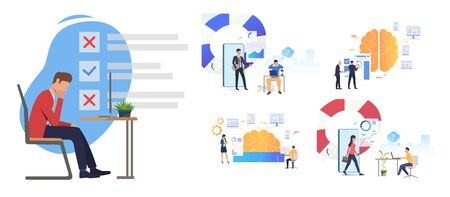1. Understanding the Digital Learning Ecosystem
In today’s fast-paced U.S. job market, staying ahead means learning new skills quickly and efficiently. Thanks to technology, it’s never been easier to access top-notch education right from your laptop or smartphone. Let’s break down what makes the digital learning ecosystem so powerful for American professionals.
The Modern Landscape of Online Education
Online education has evolved far beyond simple video tutorials. Now, you’ll find a wide range of platforms designed to fit different learning styles and career goals. Here’s a quick overview:
| Type | Examples | Main Features |
|---|---|---|
| MOOCs (Massive Open Online Courses) | Coursera, edX, Udacity | University-level courses; certificates; self-paced or scheduled classes |
| Interactive Platforms | LinkedIn Learning, Skillshare, Codecademy | Bite-sized lessons; hands-on projects; industry-relevant topics |
| E-learning Communities | Reddit forums, Discord groups, Slack channels (like Women Who Code) | Peer support; networking; real-time Q&A with experts and fellow learners |
Why Digital-First Upskilling Matters in the U.S.
American employers are looking for candidates who can adapt quickly and keep up with new trends. Many companies now value skills over degrees, especially if you can show proof of your learning—like badges or certificates from well-known platforms. Plus, online learning is flexible: you can upskill while working a full-time job or caring for family.
Key Benefits for U.S. Professionals:
- Flexibility: Learn anytime, anywhere—perfect for busy schedules.
- Affordability: Many online courses cost less than traditional college classes.
- Up-to-Date Content: Courses are regularly updated to match current industry needs.
- Diverse Choices: Whether you want tech skills or leadership training, there’s something for everyone.
The Bottom Line
If you’re looking to move up in your career or switch fields entirely, embracing online platforms and digital tools is a smart way to fast-track your skills and stand out in the U.S. workforce.
2. Finding High-Quality Online Courses and Credentials
Choosing the Right Platforms
With so many online learning options, it’s important to focus on platforms that are trusted by employers and offer top-notch content. Here are three of the most popular and reputable online education platforms in the U.S.:
| Platform | Strengths | Popular Topics |
|---|---|---|
| Coursera | Courses from leading universities and companies Recognized certificates Flexible learning schedules |
Business, Data Science, IT, Personal Development |
| LinkedIn Learning | Integration with LinkedIn profile Professional development focus Short, practical courses |
Project Management, Marketing, Leadership, Tech Skills |
| Udemy | Huge course selection Affordable prices Lifetime access to purchased courses |
Coding, Design, Office Productivity, Lifestyle Skills |
How to Spot High-Quality Courses
- Check Ratings and Reviews: Look for courses with high ratings and lots of positive feedback.
- Instructor Credentials: Make sure instructors have real-world experience or academic backgrounds in their field.
- Syllabus Transparency: Good courses share a clear syllabus with objectives and outcomes.
- Updated Content: Technology changes fast. Choose courses updated within the last year or two.
- Employer Recognition: Some platforms mark courses or certificates as “employer recognized” or “industry aligned.” This helps boost your resume value.
The Value of Certificates and Micro-Credentials
Earning certificates or micro-credentials can help you stand out in the job market. Here’s how they add value:
- Showcase Your Skills: You can display badges and certificates directly on your LinkedIn profile or resume.
- Demonstrate Commitment: Completing a series of related courses shows potential employers that you’re dedicated to learning and growth.
- Add Credibility: Certifications from well-known organizations (like Google, Microsoft, or top universities) carry extra weight with hiring managers.
- Create Career Pathways: Some programs offer “micro-degrees” that stack towards full degrees if you want to keep advancing your education later on.
Quick Tips for Getting Started
- Set a clear goal for what you want to learn—focus makes it easier to choose the right course.
- Add completed certificates to your LinkedIn profile under “Licenses & certifications.”
- If possible, join course discussion groups or forums for networking opportunities.
- Pace yourself—set aside regular time each week for online learning to stay consistent.

3. Personalizing Your Learning Experience with Tech Tools
With so many tech tools and online resources available today, you can completely customize your skill-building journey to fit your lifestyle and learning preferences. Americans love flexibility and self-direction, and using the right technology makes it easy to learn on your own terms. Let’s look at some popular ways to personalize your learning experience:
Adaptive Learning Platforms
Adaptive learning platforms use smart algorithms to adjust course material based on your progress and performance. This means you spend more time on areas where you need improvement and move quickly through topics you already know. Examples include Coursera, Khan Academy, and LinkedIn Learning.
Benefits of Adaptive Learning
| Feature | How It Helps You |
|---|---|
| Customized Content | Focuses on what you need to learn most |
| Real-Time Feedback | Shows your strengths and weaknesses instantly |
| Paced for You | Lets you speed up or slow down as needed |
Mobile Apps for Skill-Building On the Go
If you’re always busy or traveling, mobile apps are a perfect solution. With apps like Duolingo for languages, Udemy for professional skills, or Memrise for quick lessons, you can squeeze in learning whenever you have a few spare minutes—whether that’s during your commute or while waiting in line at the coffee shop.
Why Use Mobile Apps?
- Anytime, Anywhere: Learn wherever you are with your phone or tablet.
- Bite-Sized Lessons: Short modules make it easy to keep progressing.
- Push Notifications: Get reminders to help build daily habits.
Organize Your Learning with Calendar Tools
A big part of fast-tracking your skills is staying organized. Digital calendars and scheduling tools like Google Calendar, Outlook, or Trello help you set study times, track deadlines, and balance learning with everything else in your life. Setting reminders or blocking out time for practice sessions keeps you accountable without feeling overwhelmed.
Sample Weekly Skill-Building Schedule
| Day | Activity | Tool/App Example |
|---|---|---|
| Monday | Watch an online course video | YouTube, Coursera |
| Wednesday | Practice with a mobile app (15 min) | Duolingo, Memrise |
| Friday | Review notes & set next week’s goals in calendar tool | Trello, Google Calendar |
| Weekend | Take a quiz or join a discussion forum | Khan Academy, Reddit Study Groups |
Your Personalized Path Forward
The beauty of leveraging technology is that it puts you in the driver’s seat. By mixing adaptive platforms, mobile apps, and scheduling tools, you create a learning routine that fits your life and moves at your pace. In today’s fast-changing world, these tech solutions empower you to build new skills faster—and smarter—than ever before.
4. Building a Professional Portfolio Using Online Platforms
Why a Digital Portfolio Matters in the U.S. Job Market
In today’s competitive job market, U.S. employers want to see more than just a resume. They look for clear proof of your abilities and real-world projects you’ve worked on. Creating a professional portfolio using online platforms is a powerful way to stand out. By showcasing your work on digital platforms, you give recruiters easy access to your skills and creativity.
Top Online Platforms for Showcasing Your Skills
| Platform | Best For | Key Features |
|---|---|---|
| GitHub | Coding, software development, tech projects | Version control, code sharing, open-source collaboration |
| Behance | Design, creative work, portfolios | Visual portfolio display, networking with creatives, project collections |
| Personal Website | All fields, customized branding | Full control over content, blog integration, multimedia support |
How to Get Started with Your Online Portfolio
Step 1: Choose the Right Platform(s)
Select platforms that match your skills and industry. For example, if you’re a developer, GitHub is essential. Designers and artists should consider Behance. A personal website works for almost everyone and lets you personalize your brand.
Step 2: Highlight Key Projects and Skills
Add examples of your best work. Briefly explain each project: what you did, which skills you used, and what results you achieved. Use screenshots, links, or short videos when possible.
Step 3: Keep Your Portfolio Updated
Regularly add new projects or achievements. An up-to-date portfolio shows employers that you’re active and always improving your skills.
Tips for Making Your Portfolio Stand Out:
- Use simple language and clean layouts.
- Add testimonials from people you’ve worked with.
- Include contact information so employers can easily reach out.
- If possible, link your portfolio in your LinkedIn profile or resume.
A well-crafted online portfolio makes it easy for U.S. employers to see exactly what you can do—helping you fast-track your career growth by leveraging technology effectively.
5. Networking and Community Engagement in Virtual Spaces
Why Online Communities Matter
When it comes to fast-tracking your skills, learning from others is just as important as studying on your own. Online communities, forums, and meetups offer a great way to connect with industry peers, share knowledge, and stay updated on the latest trends—all from the comfort of your home.
Popular Platforms for Professional Networking
| Platform | Main Features | Best For |
|---|---|---|
| Slack | Real-time messaging, topic-based channels, direct networking | Tech professionals, startups, niche interest groups |
| Discord | Voice/video chat, text channels, community events | Developers, gamers, creative communities |
| Meetup.com | Find and join local or virtual events, workshops, group discussions | Industry meetups, skill-building sessions, casual networking |
| Reddit & Forums | User-generated content, Q&A threads, upvoting system | Getting advice, sharing experiences, problem-solving together |
The Benefits of Joining Online Communities
- Expand Your Network: Connect with professionals around the globe and grow your network beyond physical boundaries.
- Stay on Top of Trends: Be the first to know about new technologies, industry news, and upcoming opportunities.
- Get Real-Time Feedback: Share your work or ideas and receive instant input from peers who understand your field.
- Lifelong Learning: Access resources like webinars, articles, and workshops curated by the community.
- Supportive Environment: Find mentors and friends who can guide you through challenges and celebrate your wins.
How to Get Started
- Pick Your Platform: Choose a platform that matches your interests and industry needs.
- Create a Profile: Introduce yourself so people know who you are and what you’re looking for.
- Join Relevant Groups: Look for channels or groups focused on your specific skills or career goals.
- Engage Consistently: Ask questions, share insights, and participate in discussions to build relationships.
- Attend Virtual Events: Sign up for online meetups or webinars to learn directly from experts and peers.
Your Next Step: Dive In!
You don’t have to wait for an in-person event to start building your network or learning new things. With so many online platforms available, you can connect with industry leaders and like-minded professionals anytime. Explore different communities today to see which one feels right for you!

